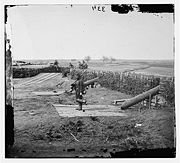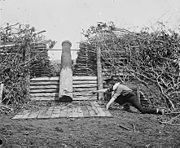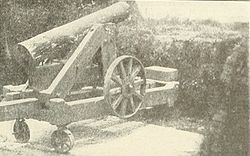
Quaker Gun
Encyclopedia


Military deception
Military deception is an attempt to amplify, or create an artificial fog of war or to mislead the enemy using psychological operations, information warfare and other methods. As a form of strategic use of information , it overlaps with psychological warfare...
that was commonly used in warfare during the 18th and 19th centuries. Although resembling an actual cannon
Cannon
A cannon is any piece of artillery that uses gunpowder or other usually explosive-based propellents to launch a projectile. Cannon vary in caliber, range, mobility, rate of fire, angle of fire, and firepower; different forms of cannon combine and balance these attributes in varying degrees,...
, the Quaker Gun was simply a wooden log, usually painted black, used to deceive an enemy. Misleading the enemy as to the strength of an emplacement was an effective delaying tactic. The name derives from the Religious Society of Friends
Religious Society of Friends
The Religious Society of Friends, or Friends Church, is a Christian movement which stresses the doctrine of the priesthood of all believers. Members are known as Friends, or popularly as Quakers. It is made of independent organisations, which have split from one another due to doctrinal differences...
or "Quakers", who have traditionally held a religious opposition to war and violence in the Peace Testimony
Peace Testimony
Peace testimony, or testimony against war, is a shorthand description of the action generally taken by members of the Religious Society of Friends for peace and against participation in war. Like other Quaker testimonies, it is not a "belief", but a description of committed actions, in this case...
.
The original "Quaker Gun trick"
During the American War of Independence, after nearly a year of brutal backcountry conflict between American Colonel William WashingtonWilliam Washington
William Washington , was an officer of the Continental Army during the American Revolutionary War, who held a final rank of Brigadier General in the newly created United States after the war...
and the fierce British commander Lieutenant Colonel Banastre Tarleton
Banastre Tarleton
General Sir Banastre Tarleton, 1st Baronet, GCB was a British soldier and politician.He is today probably best remembered for his military service during the American War of Independence. He became the focal point of a propaganda campaign claiming that he had fired upon surrendering Continental...
, Colonel Washington had retreated to North Carolina
North Carolina
North Carolina is a state located in the southeastern United States. The state borders South Carolina and Georgia to the south, Tennessee to the west and Virginia to the north. North Carolina contains 100 counties. Its capital is Raleigh, and its largest city is Charlotte...
in October 1780.
Ordered to return to lead an irregular force of colonial dragoons in the South Carolina
South Carolina
South Carolina is a state in the Deep South of the United States that borders Georgia to the south, North Carolina to the north, and the Atlantic Ocean to the east. Originally part of the Province of Carolina, the Province of South Carolina was one of the 13 colonies that declared independence...
theater by Brigadier General
Brigadier General
Brigadier general is a senior rank in the armed forces. It is the lowest ranking general officer in some countries, usually sitting between the ranks of colonel and major general. When appointed to a field command, a brigadier general is typically in command of a brigade consisting of around 4,000...
Daniel Morgan
Daniel Morgan
Daniel Morgan was an American pioneer, soldier, and United States Representative from Virginia. One of the most gifted battlefield tacticians of the American Revolutionary War, he later commanded troops during the suppression of the Whiskey Rebellion.-Early years:Most authorities believe that...
, Colonel Washington still lacked the proper artillery
Artillery
Originally applied to any group of infantry primarily armed with projectile weapons, artillery has over time become limited in meaning to refer only to those engines of war that operate by projection of munitions far beyond the range of effect of personal weapons...
to dislodge the Loyalists. On December 4, the Americans, were able to trap the Loyalist
Loyalist
In general, a loyalist is someone who maintains loyalty to an established government, political party, or sovereign, especially during war or revolutionary change. In modern English usage, the most common application is to loyalty to the British Crown....
Colonel Rowland Rugeley and his company of 125 or so men in Rugeley’s house and barn near Camden, South Carolina
Camden, South Carolina
Camden is the fourth oldest city in the U.S. state of South Carolina and is also the county seat of Kershaw County, South Carolina, United States. The population was an estimated 7,103 in 2009...
. He told his cavalrymen to dismount and surround the barn. While out of Rugeley’s sight, Washington’s men fabricated a pine log to resemble a cannon.
This so-called "Quaker Gun Trick" worked quite effectively. Colonel Washington faced the fake cannon toward the buildings in which the Loyalists had barricaded themselves and threatened bombardment if they did not surrender. Shortly afterwards, Rugeley surrendered his entire force without a single shot being fired.
Usage during the American Civil War

American Civil War
The American Civil War was a civil war fought in the United States of America. In response to the election of Abraham Lincoln as President of the United States, 11 southern slave states declared their secession from the United States and formed the Confederate States of America ; the other 25...
. The Confederate States Army
Confederate States Army
The Confederate States Army was the army of the Confederate States of America while the Confederacy existed during the American Civil War. On February 8, 1861, delegates from the seven Deep South states which had already declared their secession from the United States of America adopted the...
frequently used them to compensate for a shortage of artillery. They were painted black at the muzzle, and positioned behind fortifications to delay Union
Union Army
The Union Army was the land force that fought for the Union during the American Civil War. It was also known as the Federal Army, the U.S. Army, the Northern Army and the National Army...
assaults on those positions. On occasion, real gun carriages were used to complete the deception.
Perhaps the most famous use of Quaker Guns was by Confederate General Joseph E. Johnston
Joseph E. Johnston
Joseph Eggleston Johnston was a career U.S. Army officer, serving with distinction in the Mexican-American War and Seminole Wars, and was also one of the most senior general officers in the Confederate States Army during the American Civil War...
who placed Quaker Guns in his field works around Centreville, Virginia
Centreville, Virginia
Centreville is an unincorporated community in Fairfax County, Virginia, United States. Recognized by the U.S. Census Bureau as a Census Designated Place , the community population was 71,135 as of the 2010 census and is approximately west of Washington, DC.-Colonial Period:Beginning in the 1760s,...
in March 1862, to indicate that the works were still occupied while, in fact, the Confederates were withdrawing to the Rappahannock River
Rappahannock River
The Rappahannock River is a river in eastern Virginia, in the United States, approximately in length. It traverses the entire northern part of the state, from the Blue Ridge Mountains in the west, across the Piedmont, to the Chesapeake Bay, south of the Potomac River.An important river in American...
.
Another major example occurred during the Siege of Corinth
Siege of Corinth
The Siege of Corinth was an American Civil War battle fought from April 29 to May 30, 1862, in Corinth, Mississippi.-Background:...
: "During the night of May 29, the Confederate army moved out. They used the Mobile and Ohio Railroad to carry the sick and wounded, the heavy artillery, and tons of supplies. When a train arrived, the troops cheered as though reinforcements were arriving. They set up dummy Quaker Guns along the defensive earthworks. Camp fires were kept burning, and buglers and drummers played. The rest of the men slipped away undetected..."
Quaker Guns were also used to bolster numerous Confederate fortifications during the Siege of Petersburg
Siege of Petersburg
The Richmond–Petersburg Campaign was a series of battles around Petersburg, Virginia, fought from June 9, 1864, to March 25, 1865, during the American Civil War...
and greatly assisted in lengthening the amount of time the Rebels were able to hold their positions against the overwhelmingly superior and overbearing Union troops.
Usage during World War II
A similar idea was employed during the Doolittle RaidDoolittle Raid
The Doolittle Raid, on 18 April 1942, was the first air raid by the United States to strike the Japanese Home Islands during World War II. By demonstrating that Japan itself was vulnerable to American air attack, it provided a vital morale boost and opportunity for U.S. retaliation after the...
, which occurred in the early stages of the Pacific War
Pacific War
The Pacific War, also sometimes called the Asia-Pacific War refers broadly to the parts of World War II that took place in the Pacific Ocean, its islands, and in East Asia, then called the Far East...
of World War II, where Lieutenant Colonel Jimmy Doolittle
Jimmy Doolittle
General James Harold "Jimmy" Doolittle, USAF was an American aviation pioneer. Doolittle served as a brigadier general, major general and lieutenant general in the United States Army Air Forces during the Second World War...
led a squadron of B-25 Mitchell
B-25 Mitchell
The North American B-25 Mitchell was an American twin-engined medium bomber manufactured by North American Aviation. It was used by many Allied air forces, in every theater of World War II, as well as many other air forces after the war ended, and saw service across four decades.The B-25 was named...
s to bomb Tokyo. In order to help protect the planes from tail-end attacks, the model of B-25 flown by Doolittle's men, the B model, had fake machine guns consisting of a pair of broomsticks painted black mounted at the tail end of the fuselage to simulate tail guns. The real guns had been removed along with most of the armor to lighten the planes enough to carry the additional fuel needed to reach Tokyo.
Similarly, while preparing for the coming invasion of France, the German
Nazi Germany
Nazi Germany , also known as the Third Reich , but officially called German Reich from 1933 to 1943 and Greater German Reich from 26 June 1943 onward, is the name commonly used to refer to the state of Germany from 1933 to 1945, when it was a totalitarian dictatorship ruled by...
forces on Pointe du Hoc
Pointe du Hoc
Pointe du Hoc is a clifftop location on the coast of Normandy in northern France. It lies 4 miles west of Omaha Beach, and stands on 100 ft tall cliffs overlooking the sea...
moved their artillery battery and replaced it with upturned logs and barrels in order to fool the invading Allied forces
Allies of World War II
The Allies of World War II were the countries that opposed the Axis powers during the Second World War . Former Axis states contributing to the Allied victory are not considered Allied states...
.
The pre–World War I British battleship HMS Centurion
HMS Centurion (1911)
HMS Centurion was the second battleship of the King George V class, built at HM Dockyard, Devonport.The Battleships of the King George V class had been designed as Dreadnought Battleship....
was obsolete and disarmed by World War II. However, from 1942 to 1944, she was fitted with wooden guns and stationed in the eastern Mediterranean, to make British naval forces in the area seem stronger than they were.
Wooden cannon
Unlike a Quaker gun, a Wooden cannonWooden cannon
Wooden cannons are cannons made of wood, sometimes reinforced with straw or rope bindings or metal rings.-Expedient technique:The use of wood for cannon making could be dictated either by the lack of metal, or the lack of skill to engineer metallic cannons. Wooden cannons were notoriously weak, and...
is a functional weapon, albeit notoriously weak and only able to fire a few shots, sometimes even just one shot, before bursting. These were used by those without access to metal or the skill to engineer metallic cannons.
Further reading
.- Latimer, Jon (2001), Deception in War, pp. 26–9. London: John Murray. ISBN 0-7195-5605-8.

